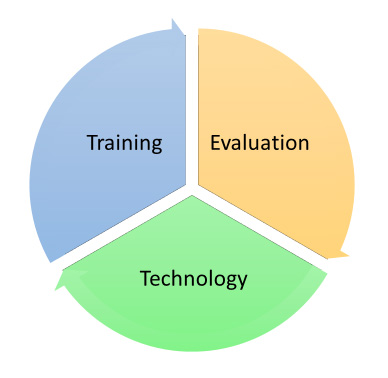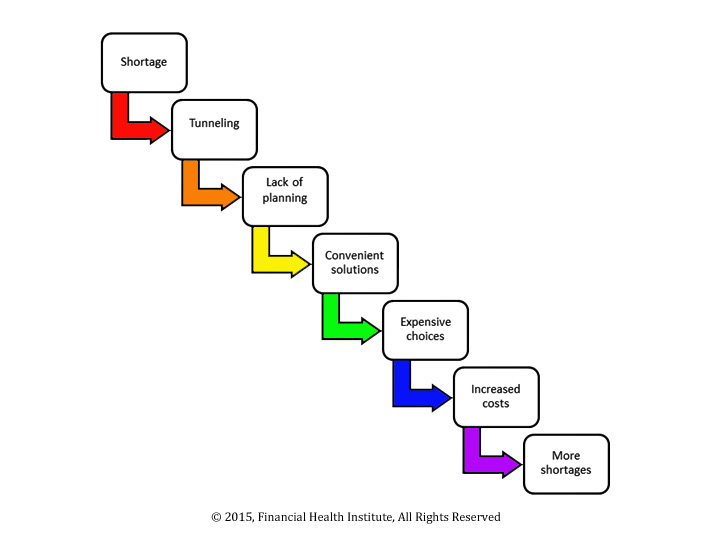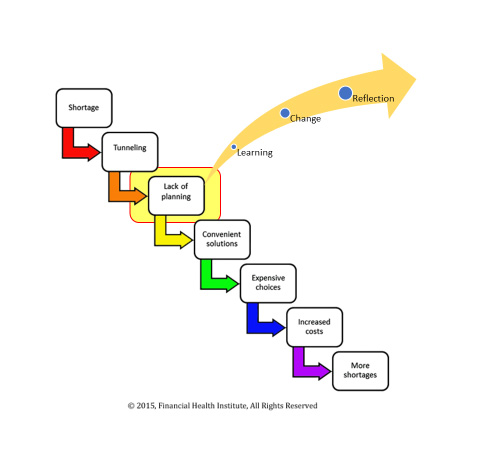
From Organizational Scarcity to Integrated Learning
We all know what scarcity feels like, but how does it impact our lives and what can we do about it? And how does scarcity impact the organizations that are helping people address the scarcity in their lives?
In 2013, Mullainathan and Shafir released a book about it called, naturally enough, Scarcity. The research and findings in this book had a profound impact on me (and I highly recommend reading it if you haven’t yet). If you’ve been in any of my trainings, you’ve heard me talk about it; in fact, I spend a significant amount of time discussing scarcity because of the immense impact it has on decision-making, which is so critical in how we use our economic resources.
The authors define “Scarcity” as “having less than you feel you need.” A main premise in this book is that when people experience scarcity they begin to behave predictably irrational. That is to say, humans experiencing chronic scarcity tend to behave even less rationally than when we are not experiencing scarcity. (Note: the concept of rationality is a fascinating rabbit hole to go down in another conversation.) What I truly love about the book is that it makes the sometimes bizarre decisions that humans make more…well, human. It’s not about poor people, or uneducated people or some “other” people: it’s about humans. All of us. You and me.
The Shortages Cascade
I created a visual model based off the steps that Mullainathan and Shafir describe in their book, a process they refer to as the “scarcity trap.”

When people move into this trap, it can become difficult to use their executive functions and their ability to plan for the future can become impaired. When I present this visual representation in trainings, people very quickly recognize the pattern. It’s just that common.
Well, if you read a little further into the book, the authors talk very briefly about “organizational scarcity.” They demonstrate that organizations, being made up of people, can actually experience scarcity too. And when organizations have less than they “feel” they need, they too can behave “irrationally.”
What is Organizational Scarcity?
In 2016, FHI was given the opportunity by the Denver CSBG program and the Colorado Division of Local Affairs (DOLA) to deliver a symposium on “organizational scarcity,” which we titled the “Symposium on Scarcity.” (I have always been bad with naming things, so it’s okay to roll your eyes at the title of this event.) The purpose of the event and what came out of it has had a significant impact on me and the work of FHI.
Take a look at this video and see if you think these clients capture the essence of organizational scarcity accurately:
Surely, we are doing good. But surely, we can do better!
Navigating Organizational Scarcity
For our symposium, we set about finding organizations that had successfully navigated scarcity and looked for common themes. It was interesting to note the common concepts and strategies that these organizations used to help them find a path out of organizational scarcity. And it is equally interesting how very similar the organizational paths are to the paths individuals take.

Making time and space for planning is the key to navigating out of the shortages cascade, for individuals and for organizations.
As a result of what we learned from the Symposium on Scarcity, I wanted to determine how FHI could help organizations better utilize their resources in alignment with their mission and vision, just like we do with individuals. Would it be possible to help human services and economic development organizations be more efficient and effective? And how can we help organizations avoid falling into the organizational scarcity trap?
Technology, Training & Evaluation
For the last three years, FHI has evolved to allow us to more significantly focus on helping organizations be more efficient and effective in how they deliver and implement training, and ultimately in how they work with the people they serve. We have identified three capacities that we now fully integrate into our practice and that we hope to help other organizations begin to use more effectively: Technology, Training & Evaluation.

For example, we launched our Integrated Learning Programs, which bring down the cost of training while simultaneously allowing us to help people integrate the training into practice. Plus, we have the ability to monitor whether or not the training is being used over a longer period of time. That is, we can actually track outcomes beyond pre/post surveys, and evaluate the long-term efficacy of the programs.
Looking Into the Future
Here are some areas that FHI is exploring:
- Case Manager Competencies – from pre-employment through supervisor skills
- Integrated Learning for Motivational Interviewing
- Integrated Learning for Trauma Informed Approaches
- Conferences – Long-term Efficacy and Integration
- Developing Organizational Training Strategies
- Operational Excellence in NPO’s
- Community Systems for Economic Mobility
We will continue to develop our own expertise in these areas, like our robust Integrated Learning Programs and online learning. But we are also reaching out to find help from other organizations and individuals that can help us be a better resource to the human services and economic development worlds. If you are interested in learning more about our direction or wish to get involved, please send me a note! I’d love to hear your thoughts!

